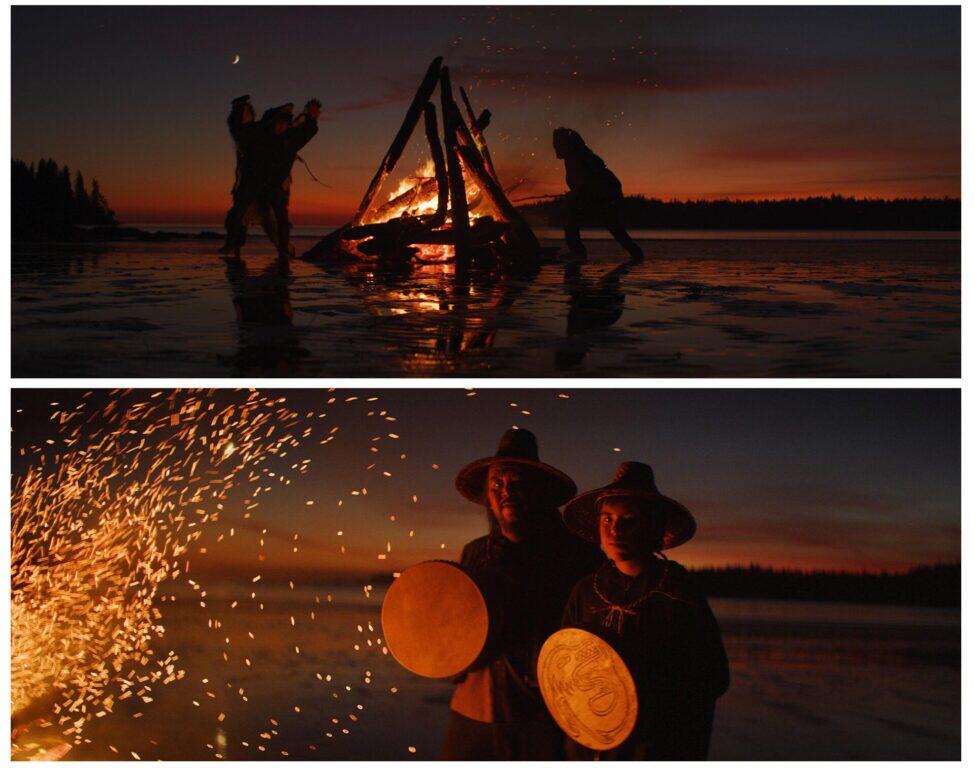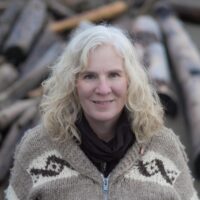Occupied since before the great pyramids were built, the archeological site on Vancouver Island holds the key to the history and future of the Huu-ay-aht First Nations.
Touring through the ancient rainforest village of Kiix̣in (pronounced “kee-hin”) isn’t just about the past. At this remote archaeological site in British Columbia, cultural guides explain how different plants and medicines are found and used, describe how the buildings were constructed, and weave together traditional Huu-ay-aht oral history stories with modern archeological discoveries to paint a picture of a contemporary and thriving culture.
INSIDER TIPWear sturdy shoes and consider bringing a hiking pole—you’ll be climbing over roots and rocks as you discover ancient big houses.
When Wishkey (Rob Dennis Jr.), a cultural guide with the Huu-ay-aht First Nations, was in elementary school, he went on a field trip that changed his life. Rather than heading to a bowling alley or off to a movie theater, he traveled with his classmates from his home in Bamfield, just south of Tofino and Ucuelet on British Columbia’s Vancouver Island, into a site in the surrounding rainforest where archeologists were surveying an ancient Huu-ay-aht village called Kiix̣in.
Back then, around 1984, archeologists were just starting to get a sense of Kiix̣in’s importance. They knew the site was a rarity. Of what once had been more than 100 First Nations villages on the southern British Columbian coast, Kiixin was the only one that still had standing traditional architecture–and it showed over 5,000 years of continuous occupation. It was also strategically significant. Set in a protective defensive location, the village had both a fortress and at least eight traditional big houses.
Recommended Fodor’s Video
Like archeological ruins in other places, Kiix̣in at first seems to tell the story of old ruins and an ancient and forgotten people.
For Wishkey, being a kid exploring an active archeological site was cool. But it was the fact that the village was a place where his ancestors had once thrived that changed how he perceived himself as an indigenous person. He explains that while hearing about Kiix̣in from the archeologists was interesting, learning stories about the village from his dad and other elders helped him understand that his people had been connected to the land for thousands and thousands of years. “It made me realize I wanted to know more about my indigenous culture,” says Wishkey.
Up until recently, Kiix̣in was a place that had become more appealing to vandals than tourists. Long pillaged of some of its greatest treasures (the village’s remarkable welcome figures were taken in 1909 and now stand in the entrance to the Royal BC Museum in Victoria until the Huu-ay-aht can bring them home,) Kiix̣in could have been reclaimed by the forest and forgotten. Instead, the place the Huu-ay-aht have always known as their First Village, or capital, became a symbol of resilience: a place where modern-day Huu-ay-aht people are reclaiming their customs and beliefs.
Like archeological ruins in other places, Kiix̣in at first seems to tell the story of old ruins and an ancient and forgotten people. Listed on the Canadian Register of Historic Places in 1999 and first opened to tourists in 2017, visitors on the guided 3-and-a-half-hour tour naturally expect to be steeped in the past when they wander along the boardwalk through the cedar-scented forest.

Instead, when visitors arrive, Wishkey says he wants them to understand his people still live in this landscape and their culture is still alive, “By coming here, visitors learn they’re our guests and that they’re helping us write the next great part of the Huu-ay-aht story.”
Set above the rocky foreshore of what Wishkey calls, “the most beautiful beach in the world,” visitors are encouraged to take their time immersing in the sounds, sights, and smells of the ocean. With tidal pools filled with abalone, mussels, scallops, and sea stars, along beachcombing, and wildlife watching, it’s easy to lose yourself on the beach and begin to imagine how generous the landscape was to the people who lived here.
After a while, using his hand drum to gather his guests, Wishkey introduces the Nuu-Chah-Nulth language of his ancestors, a language he loves and is working hard to learn, teach, and revitalize.
Sharing stories and songs from both the past and the present, Wishkey begins to introduce the landscape and the village’s story, “I have a bit of a playlist. Some of the songs are inherited, some are connected to the village, and some are ones I made myself.”

Above the shoreline Kiix̣in gradually reveals itself. At first it’s hard to understand what you’re seeing; house posts, fallen logs and nurse trees blend together like forest debris, and ferns and salal bushes cover parts of the ancient structures. Traditional construction techniques are obscured by moss and can easily be missed. But then the patterns begin to emerge, the stories take hold, and the reality that you’re standing in a village that was occupied when the great pyramids were being built sinks in.
“The site is dated to over 5,500 years. I like to show people how our traditional stories are connected to the archeological signs and evidence.” Wishkey explains. “Together they show how we know we’ve been in existence here for so very long.”
Set on the traditional trade routes that went from Alaska to California, the region’s richness made it easy for villagers to fish, hunt, and gather plants and medicines. Wishkey explains how his people lived within nature’s rhythms and made careful use of everything around them so everything they needed would last for generations.
While it’s easy to imagine an idyllic village life filled with abundance, art, and song, Kiix̣in’s strategic location also resulted in warfare. Huu-ay-aht oral histories say in about 1700, a war party from the Klallam tribe paddled across from Olympic Peninsula in Washington State and attacked the village. Survivors fled up the Pachena River. Because Kiix̣in was the site of so much death, it was abandoned.
Through the brutality of colonization, some of our wisest and most compassionate teachers were systematically silenced.
Historians think the village may have been briefly inhabited again the 19th century. During this period the Huu-ay-aht were hired to hunt sea otters and worked on sailing schooners up and down the coast. Kiix̣in didn’t have a deep enough anchorage though—so a trading post was set up in nearby Dodger’s Cove as an easier access point for ships.
As he continues to unravel the ongoing story of the village and his people, Wishkey explains that Kiix̣in’s abandonment may have been what saved it. In communities all over the coast, the results of colonization were taking a devastating toll; the reserve system pushed people off their traditional lands, then the deliberate spread of smallpox killed at least 60% of the indigenous population—an act of genocide that emptied villages and hastened social collapse. Not long after, legislation known as the potlatch laws outlawed cultural practices and children were taken from their families and sent to residential schools where speaking their own language was forbidden.

Standing amongst the beauty and serenity of tall firs, spruce, cedars, and alders, visitors begin to understand the tour is about much more than archeology.
In British Columbia, indigenous-lead tourism is playing a pivotal role in the resurgence of traditional indigenous culture. With 203 First Nations communities, more than 30 languages, and over 401 Indigenous tourism-related businesses operating in BC, it’s one of the fastest-growing tourism sectors in Canada. It’s also bringing renewed pride to communities where indigenous identity had been stripped away through the ongoing effects of colonization. By sharing their story, indigenous tour operators are not just strengthening their own culture but they’re offering tourists lessons on how to care for the land and each other.
For Wishkey, some of his favorite visitors are urban Huu-ay-aht people. “We grew up in another culture, speaking English and not learning our teachings. So it’s wonderful when they get to hear our language and our stories and reclaim their connection to the land. This is how we keep our culture alive.”
For other visitors there are often unexpected lessons that come from the ancient site. For some, it’s simply a reminder that Canada didn’t just start 152 years ago with colonization. For others, hearing the truth of the indigenous experience is the first step toward a greater understanding and reconciliation.
Some visitors begin to realize that the disruption to indigenous cultures has been a loss for all of us. Through the brutality of colonization, some of our wisest and most compassionate teachers were systematically silenced. But it’s hoped that through tourism, new teachers are beginning to gain a voice.
“Everything learned is meant to be taught,” Wishkey explains. “We’ve always known this.”

Kiix̣in is a unique and sacred classroom. There are the lessons from the past, about how people lived in harmony with the landscape by using plants and animals in a respectful way. There are also the lessons about the unfathomable cruelties we visit on one another. The greatest lesson, though, is about resilience. Wishkey explains that, somehow, after 5,500 years, Kiix̣in is still welcoming guests. “When people are walking around, especially at the potlatch house, you can almost feel the ancientness and the ancient spirits. This is the one little place in our territory where we can all go and be our ancient selves.”




